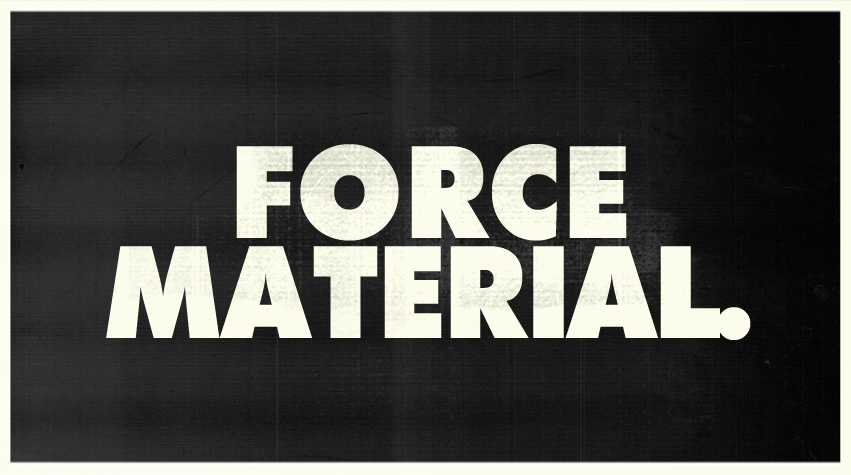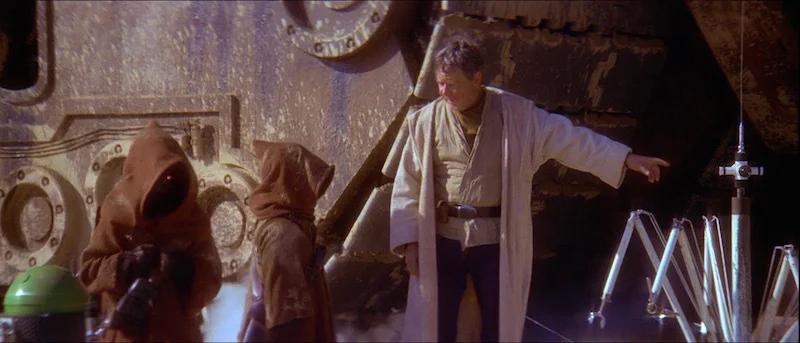2187: A Star Wars Odyssey
Most fans know that Finn's Stormtrooper designation in The Force Awakens, FN-2187, is a reference to A New Hope. But the rabbit hole goes much deeper — all the way back to the secret origin of Star Wars.
If you’re the sort of Star Wars fan who loves trivia and minutia, then Finn’s Stormtrooper designation in The Force Awakens, FN-2187, probably reminded you immediately of Princess Leia’s Death Star cell number in A New Hope.
But that wasn’t the first time the number appeared in George Lucas’ work. In his first feature film, 1971’s THX 1138, the titular character’s love interest is killed by city authorities on the date 21/87.
Before that, Lucas attended the University of Southern California’s film school. While he was there, he wrote and directed the short film that THX 1138 would eventually be spawned from, Electronic Labyrinth: THX-1138 4EB.
The short is set in the year 2187.
So it’s clear, at this point, that this is a number that has some significance for Lucas.
That significance, it turns out, goes back to a formative moment in the filmmaker’s life. At USC, Lucas was exposed to a short film produced by the National Film Board of Canada (NFB) in 1963 called, you guessed it, 21-87.
The groundbreaking short was the work of Arthur Lipsett, who was part of the NFB’s divisive Unit B, a group of experimental young filmmakers whose eccentricities and indulgences were frequently criticised by government officials.
Lipsett was actually nominated for an Oscar for another short, 1961’s Very Nice, Very Nice. That one earned Lipsett a piece of fan mail from Stanley Kubrick, who called it “one of the most imaginative and brilliant uses of the movie screen and soundtrack I have ever seen”. Kubrick even asked Lipsett to cut the trailer for Dr Strangelove, but he declined.
21-87 is a collage made, for the most part, from films that other directors working for the NFB had discarded in the editing room; it has no plot to speak of and the audio doesn’t relate directly to the visuals, but for Lucas, that was the appeal – the dissonance between the sound and the images intrigued him, and inspired him to make similarly “off the wall, abstract” shorts.
“In terms of understanding the power of sound and picture relationships, there’s no one better than Arthur Lipsett,” Lucas says in the 2006 documentary Remembering Arthur.
“In the relationship of understanding the editing — cutting from dark to light, light to dark, movement from one side to the other, going from pastoral to shocking — there’s no better example than his films.”
If there is a cohesive theme that runs through 21-87, it’s the struggle between man and machine. Religious imagery rubs up against footage of machinery at work and people going about mechanical, empty lives, their individuality subsumed by an industrial society.
The name of the short, 21-87, came from an audio snippet that plays at the conclusion of the film: “Somebody walks up and you say, ‘Your number is 21-87, isn’t it?’ Boy, does that person really smile!’”
After seeing 21-87, Lucas directed his first short films at USC, visual tone poems that were bereft of story and character but loaded with subversive sound-and-picture relationships that clearly owed a lot to Lipcott’s work.
Lucas' first ever film, the one-minute long Look at Life, presents a montage of photographs of iconic people and moments from the 1960s, while a man’s voice can be heard yelling the Biblical text, “Hate stirreth up strife, while love covereth all sins”, over an incessant drum beat. When the short comes to an end, the text “ANYONE FOR SURVIVAL” appears on screen, followed by “End” and “?”.
That was followed by shorts like Herbie, devoted solely to light streaks and flashes and set to music by Herbie Hancock, and 6-18-67, ostensibly a doco about the making of the Gregory Peck western Mackenna’s Gold that veers off into time-lapse nature photography soundtracked by the ambience of the Arizona desert.
At a glance, it might seem that George Lucas turned his back on the promise of his early experimental films when he made Star Wars; that he moved past the formative influence of Arthur Lipsett and 21-87 when he went down a far more commercial path.
But what is Star Wars, if not a mash-up of discarded pop cultural ephemera? And what is Star Wars about, if not the struggle between man and machine?
One snippet of discarded audio Lipsett used in 21-87 came from a conversation between Warren S McCulloch, the artificial intelligence pioneer, and documentarian Roman Kroitor.
During their conversation, McCulloch told Kroitor that he believes humans and animals are nothing more than complex machines. Kroitor’s reply is included in the film (it's at 3:33 of the video embedded earlier).
“Many people feel that in the contemplation of nature, and in communication with other living things," Kroiter said, "they become aware of some kind of a force, or something behind this apparent mask which we see in front of us.”
In 2006, Lucas confirmed that his own use of ‘The Force’ was “an echo of that phrase" spoken by Kroitor in 21-87.
Roman Kroitor, by the way, was also a filmmaker for the NFB’s Unit B (which is why clips of his conversation with McCulloch were lying around the editing booth for Lipsett to use in 21-87).
““Many people feel that in the contemplation of nature, and in communication with other living things, they become aware of some kind of a force, or something behind this apparent mask which we see in front of us.””
One of Kroitor’s films, 1962’s Lonely Boy – about the singer Paul Anka – pioneered the cinéma vérité style of narratorless, fly-on-the-wall documentaries.
It’s a style that Lucas himself would later dabble in with 1968’s Filmmaker – A Diary By George Lucas, his behind-the-scenes doc about the production of his friend Francis Ford Coppola’s feature, The Rain People.
Kroitor’s breakthrough, though, was 1960’s Universe, a black-and-white short that used models and animation to take viewers on a journey through space, into uncharted galaxies. It was, at that time, the most realistic and immersive depiction of space on screen, and Stanley Kubrick was among its admirers.
Just as he had tried to recruit the NFB’s Arthur Lipsett to cut a trailer for Dr Strangelove, Kubrick attempted to hire Kroitor to work on 2001: A Space Odyssey. (Kroitor declined, but Kubrick did hire Wally Gentleman, who did optical effects for Universe, to work on 2001, and cast Universe narrator Douglas Rain as the voice of HAL 9000.)
The reason Kroitor declined Kubrick’s offer was because he was immersed in an ambitious project of his own, In The Labyrinth. Created for Expo 67, In The Labyrinth was almost more of an art installation than a film — it was screened in the ‘Labyrinth pavilion’, which consisted of three chambers, one of which was a hall of mirrors, a literal labyrinth that audiences had to find their way through to be able to see the film.
In the third chamber, the film itself was projected across five screens simultaneously. The screens, provocatively arranged into the shape of a cross, would sometimes show separate images, but would also come together to display a giant mosaic of a single image.
In The Labyrinth — released, coincidentally, the same year as Lucas’ Electronic Labyrinth: THX 1138 4EB — attracted rave reviews, but the multi-screen gimmick made it virtually impossible for Kroitor to show the film outside Expo 67.
Kroitor began talking to Graeme Ferguson, a fellow Canadian filmmaker who was experiencing similar problems with his own multi-screen documentary, Polar Life, which had also screened at Expo 67. Kroitor and Ferguson formed a company together, the MultiScreen Corporation.
With Ferguson’s school friends, Robert Kerr and William C Shaw, they experimented with ways to bring their out-sized visions to the screen.
They soon realised that a single image on one large screen would have more impact than several images across multiple smaller screens, and at the request of Fujifilm — who had been wowed by In The Labyrinth at Expo 67 — they produced Tiger Child, the first film in their new ‘Image Maximum’ format, for Expo 70 in Osaka.
That’s when the Multiscreen Corporation changed its name — to IMAX.
Yes, that’s right — Roman Kroitor, the man behind the disembodied voice that accidentally inspired the Force with a throwaway line in Arthur Lipsett’s 21-87, also invented IMAX.
And in 2015, when audiences flocked to see Star Wars: The Force Awakens — the story of rogue Stormtrooper FN-2187 — on their nearest IMAX screen, all these disparate threads came together.
Obi-Wan Kenobi said it best, didn't he?
The Force — it really does bind the galaxy together.
Force Material is a podcast exploring the secrets and source material of Star Wars with hosts Rohan Williams and Baz McAlister. Listen and subscribe on iTunes, Spotify, iHeartRadio, TuneIn, Stitcher, PlayerFM and Castro; stay in touch with us on Facebook, Twitter and Instagram; and support the show by browsing our range of shirts, hoodies, kids apparel, mugs and more at TeePublic.






